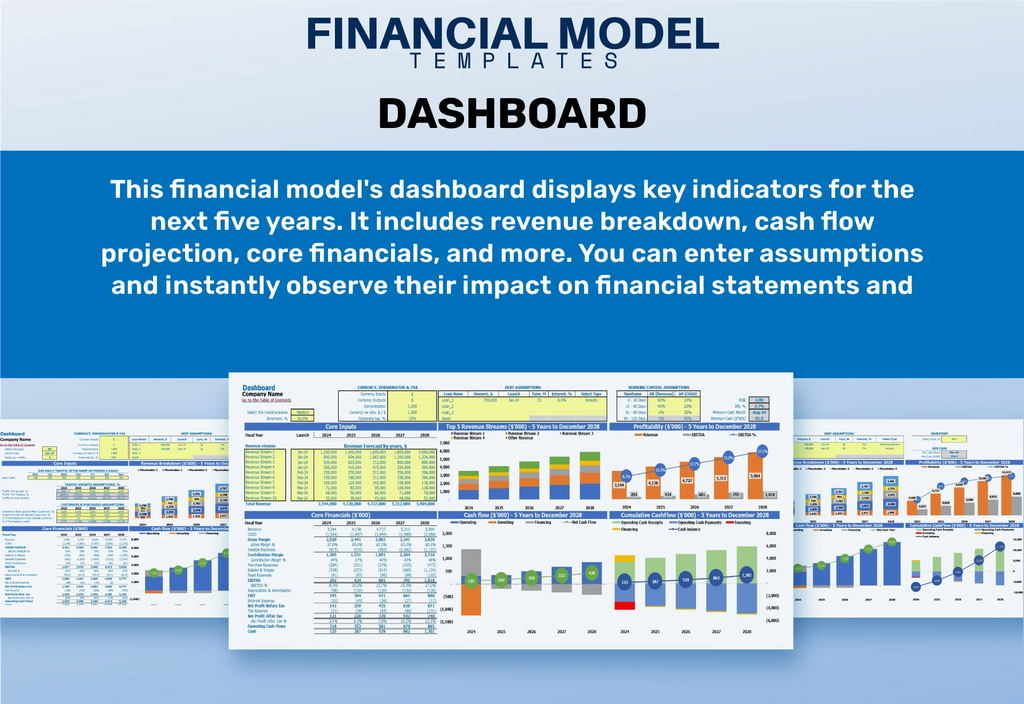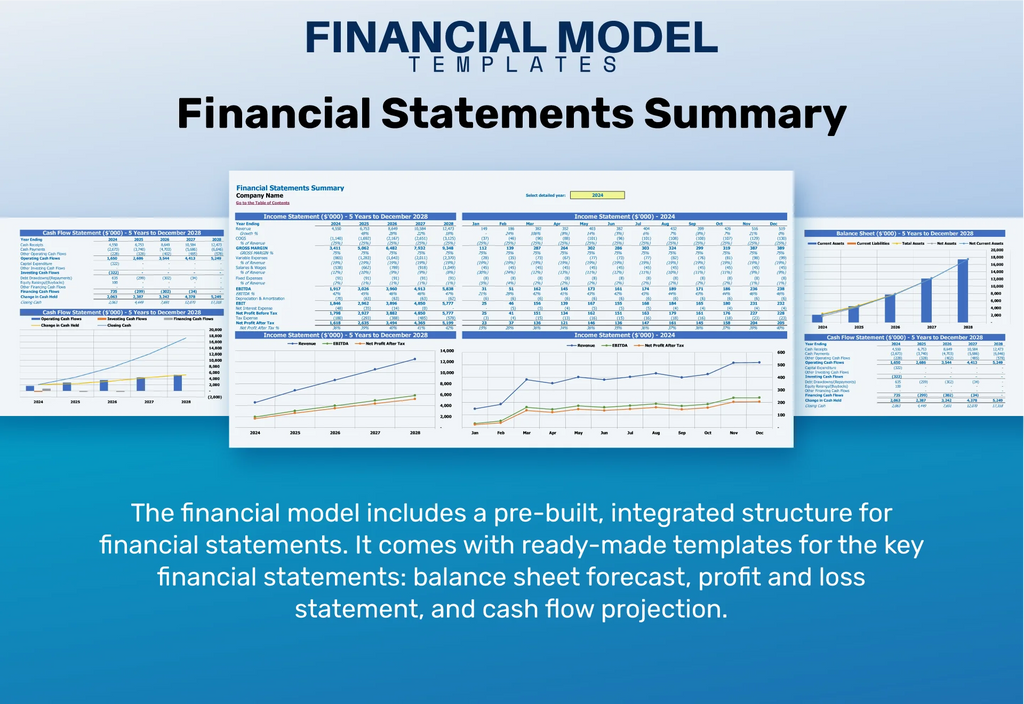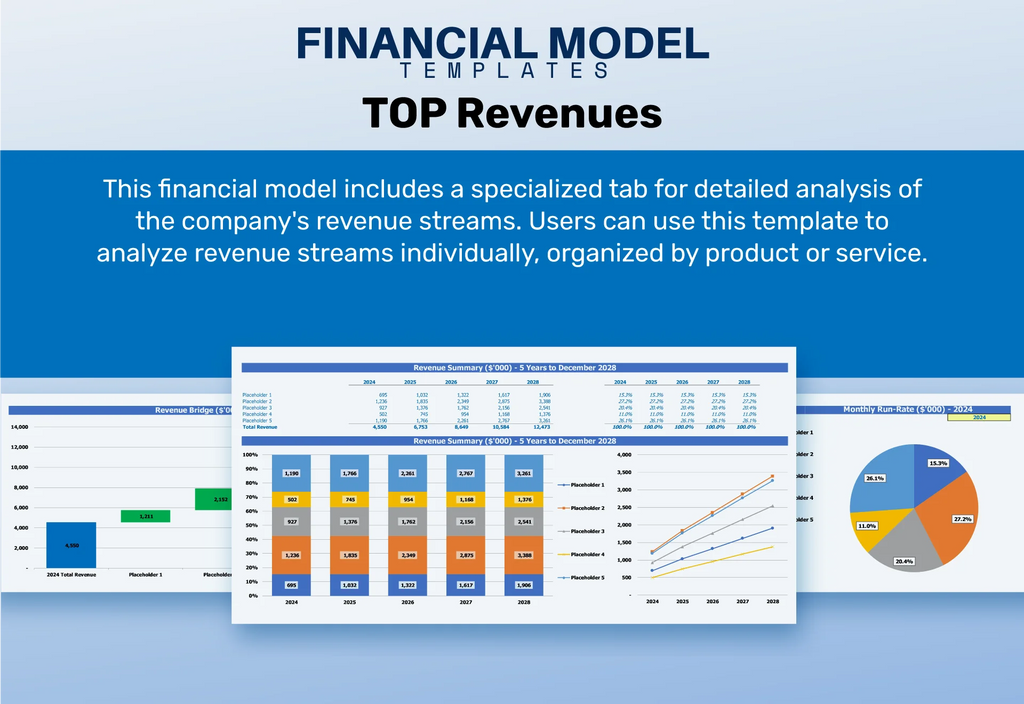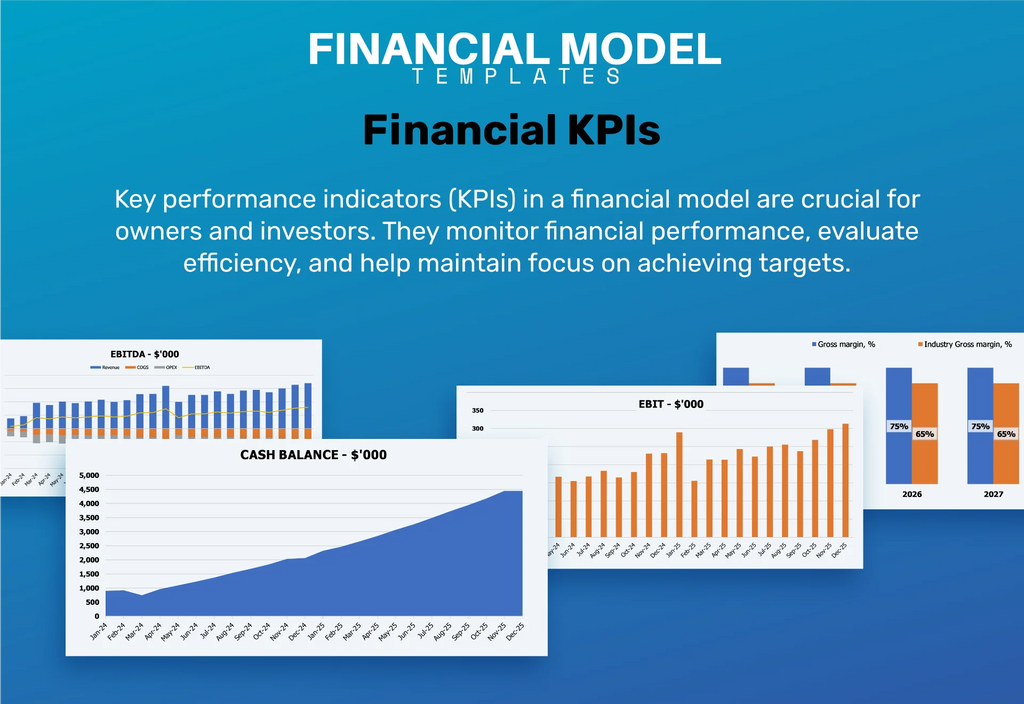Frozen Food Financial Model

- ✔ 5-Year Financial Projections
- ✔ 100% Editable
- ✔ Investor-Approved Valuation Models
- ✔ MAC/PC Compatible, Fully Unlocked
- ✔ No Accounting Or Financial Knowledge
Frozen Food Financial Model
Bundle Includes:
ALL IN ONE MEGA PACK - CONSIST OF:
frozen food store Financial Model/Business Plan Excel Template
Pitch Deck Template For PowerPoint, Keynote & Google Slides
Business Plan Guide and Business Plan Template in MS Word Format
Financial Dashboard in Excel To Track Your Business Performance
FROZEN FOOD STORE STARTUP BUDGET INFO
Highlights
The frozen food business model can significantly benefit from a comprehensive pro forma financial statements template that facilitates accurate grocery store financial projections over a five-year period. This tool is essential for both startups and existing frozen food stores, enabling them to conduct a detailed frozen food sales analysis, assess their cost structure for frozen products, and strategically plan revenue streams. In light of current market trends, effective inventory management of frozen goods is crucial, as is understanding customer demographics to tailor the marketing strategy. Additionally, analyzing the profit margin of frozen meals and operational expenses like store overhead is vital for sustainable cash flow management. A meticulous break-even analysis will help in forecasting seasonal demand and competitive positioning, while a well-defined pricing strategy ensures the store remains viable within the frozen food industry’s financial landscape.
The ready-made financial model in Excel addresses several pain points for those in the frozen food business, offering a straightforward solution for grocery store financial projections and operational expenses management. It simplifies inventory management of frozen goods, enabling users to analyze their cost structure effectively, ensuring they can maintain healthy profit margins on frozen meals while navigating seasonal demand fluctuations. The template provides clarity on supply chain dynamics and cash flow management, making it easier to assess revenue streams and conduct break-even analysis. By incorporating customer demographics and competitive analysis, it helps refine marketing strategy and pricing strategy for frozen products, ultimately catering to the unique demands of the frozen food market trends.
Description
Our frozen food store financial model is a comprehensive tool designed to assist with the startup costs and financial forecasting critical for entering the frozen food business model. It features detailed grocery store financial projections over five years, including monthly and yearly financial statements, cash flow management metrics, and relevant KPIs that can guide your pricing strategy and operational expenses. By conducting a frozen food sales analysis, this model helps identify profit margins, customer demographics, and market trends, ensuring effective inventory management and supply chain optimization. Furthermore, it includes a break-even analysis to help determine the viability of revenue streams from frozen products while also addressing competitive analysis and seasonal demand to maximize the store's cash flow and overall financial health.
FROZEN FOOD STORE FINANCIAL PLAN REPORTS
All in One Place
A comprehensive financial projection for your frozen food business integrates key elements like profit and loss statements, projected balance sheets, and cash flow forecasts into one dynamic model. Unlike simplified versions, this complete five-year template provides an accurate financial overview, enabling effective scenario planning. By assessing your cost structure, revenue streams, and operational expenses, you can evaluate the impact of changes in inventory management and pricing strategies on profit margins. This holistic approach reveals insights into customer demographics and seasonal demand, ensuring you navigate the competitive frozen food market with confidence.

Dashboard
Equipped with this comprehensive three-way financial model dashboard, stakeholders, potential investors, and lenders can easily grasp your frozen food business's financial health. This all-in-one tool offers insightful grocery store financial projections, highlighting revenue streams, operational expenses, and cash flow management specific to frozen products. Featuring clear visualizations of your financial reports and forecasts, it enables effective communication of your pricing strategy and inventory management practices while addressing market trends and customer demographics in the frozen food industry. Streamline your presentations and make informed decisions with this essential resource at your fingertips.

Business Financial Statements
Our Excel financial model offers a sophisticated template for the frozen food business, featuring consolidated financial statements, including profit and loss forecasts, projected balance sheets, and cash flow pro forma. Users can view these statements on both a monthly and annual basis, providing comprehensive insights into grocery store financial projections. Additionally, seamlessly integrate existing financial reports from QuickBooks, Xero, or FreshBooks to enhance your rolling forecasts. This tool streamlines your analysis of revenue streams, operational expenses, and cost structures, ensuring informed decision-making in a competitive frozen food market.

Sources And Uses Statement
The sources and uses statement template for our frozen food business model outlines critical funding sources and allocates these resources effectively. By analyzing grocery store financial projections, we can assess revenue streams and operational expenses, ensuring robust cash flow management. This strategic approach not only highlights our cost structure for frozen products but also supports our pricing strategy, driving profitability. Furthermore, integrating insights from frozen food sales analysis and market trends will enhance inventory management and adapt to seasonal demand, positioning our startup for sustainable growth in a competitive landscape.

Break Even Point In Sales Dollars
Breakeven analysis is essential for assessing when your frozen food business will cover expenses and start generating profit. To conduct this analysis, identify fixed costs—like rent and salaries—that remain constant regardless of sales volume. These overhead costs are crucial for understanding your cost structure. Additionally, account for variable costs, including inventory sourcing and shipping, which fluctuate with sales levels. By accurately calculating these expenses, you can establish a clear financial foundation, guiding your pricing strategy and inventory management to optimize revenue streams in the competitive frozen food market.

Top Revenue
In the frozen food business model, financial projections play a crucial role in assessing profitability. The top line, representing gross sales, reflects revenue streams from frozen products. Investors closely monitor this metric, as top-line growth signifies increased sales potential. Understanding customer demographics and market trends can enhance the marketing strategy and pricing strategy for frozen goods. Additionally, effective inventory management and cost structure are vital to controlling operational expenses. By conducting a break-even analysis and forecasting cash flow, businesses can ensure sustainable growth in the competitive frozen food market.

Business Top Expenses Spreadsheet
Understanding your spending is crucial for effective financial management in the frozen food business. The Top Expenses tab in the pro forma income statement template offers a clear overview of annual operational expenses, categorized into customer acquisition costs and fixed costs. This structured approach enables businesses to analyze their cost structure for frozen products, identifying which areas most impact their financial health. By leveraging this insight, you can enhance budgeting, refine pricing strategies for frozen goods, and ultimately improve cash flow management, ensuring sustainable growth in a competitive market.

FROZEN FOOD STORE FINANCIAL PROJECTION EXPENSES
Costs
Startup costs are essential in developing a robust frozen food business model, significantly influencing the three-statement financial model. Careful monitoring of these expenses is crucial to prevent financial setbacks and ensure adequate funding. Our five-year financial projection template includes a dedicated pro forma that outlines funding and expenditure levels. By utilizing our Excel financial model template regularly, businesses can achieve effective inventory management and optimize their pricing strategy, keeping pace with frozen food market trends. This proactive approach enhances financial forecasting and operational efficiency, setting the foundation for sustainable growth and profitability.

CAPEX Spending
In the Top Revenue tab of this financial planning model, users can effectively forecast demand for each product or service offered, enhancing decision-making for the frozen food business model. This report simulates potential profitability, providing valuable insights into revenue streams and financial attractiveness for various scenarios. Users can analyze revenue depth and identify trends, facilitating improved inventory management for frozen goods. Moreover, understanding daily demand fluctuations allows for optimized resource allocation, including manpower and inventory, ensuring efficiency and profitability in the competitive frozen food market.

Loan Financing Calculator
Navigate the complexities of your frozen food business with our comprehensive five-year financial projection template. Designed for precision, it includes a built-in loan amortization schedule to simplify cash flow management. By inputting your total loan amount, tenor, and maturity, the tool calculates regular repayments, detailing both principal and interest. All essential details—interest rate, tenor, maturity date, and repayment schedule—are streamlined for easy access. Enhance your operational efficiency and strategic planning in the frozen food market with accurate financial forecasting and insights into your cost structure and potential revenue streams.

FROZEN FOOD STORE INCOME STATEMENT METRICS
Financial KPIs
Key performance indicators (KPIs) play a vital role in your frozen food business model, serving as essential tools for both owners and investors. These metrics enable you to evaluate financial projections and analyze the efficiency of your cost structure and revenue streams. By closely monitoring KPIs, you and your co-founders can pinpoint customer demographics, optimize inventory management, and refine your marketing strategy. Ultimately, this data-driven approach ensures you maintain a strong profit margin and navigate market trends effectively, facilitating informed decisions that drive growth and sustainability in the competitive frozen food industry.

Cash Flow Forecast Excel
Developing a cash flow statement is crucial for a frozen food startup's pro forma template, marking a vital stage in the financial forecasting process. The projections on the cash flow model are significantly influenced by variations in the pro forma balance sheet and specific non-cash items from the income statement. A well-structured cash flow analysis not only enhances inventory management but also supports effective pricing strategies and operational expense oversight. This meticulous approach enables the frozen food business to navigate market trends, manage seasonal demand, and optimize revenue streams, ultimately ensuring sustainable profitability in a competitive landscape.

KPI Benchmarks
The startup costs spreadsheet includes a benchmark tab that calculates key performance indicators essential for evaluating your frozen food business model. By comparing these metrics against competitors, you gain insights into operational efficiency and strategic positioning. This comparative analysis is crucial for financial forecasting and setting realistic grocery store financial projections. Understanding these benchmark indicators allows for informed decision-making in areas such as inventory management and pricing strategy. Ultimately, utilizing these insights ensures that your frozen food store remains competitive and aligned with market trends, paving the way for enhanced profitability and effective cash flow management.

P&L Statement Excel
Managing a frozen food store requires precise financial insights, making your profit and loss statement essential. Our user-friendly profit and loss statement template simplifies the calculation of revenue streams and operational expenses, facilitating accurate financial forecasting for your frozen products. By utilizing our template, you can effectively analyze potential profit margins, seasonal demand, and supply chain dynamics, ensuring your grocery store remains competitive. Take control of your cash flow management and enhance inventory management with this invaluable tool to achieve your business goals in the evolving frozen food market.

Pro Forma Balance Sheet Template Excel
In your startup venture, a projected balance sheet is essential for assessing financial health and stability. This report details current and long-term assets, liabilities, and equity, offering insights into your frozen food business model. Moreover, a pro forma balance sheet is invaluable for calculating key financial ratios, supporting effective inventory management and cash flow management. By analyzing this data, you can refine your pricing strategy, optimize operational expenses, and navigate supply chain dynamics. Understanding these metrics will empower your business to thrive amid market trends and seasonal demand fluctuations in the competitive frozen food landscape.

FROZEN FOOD STORE INCOME STATEMENT VALUATION
Startup Valuation Model
Leverage our comprehensive valuation template within the three-statement financial model to equip your investors with essential insights. The weighted average cost of capital (WACC) reflects your frozen food business model's overall capital cost, including equity and debt. Utilize discounted cash flow (DCF) analysis to project future cash flows, facilitating informed financial forecasting. By addressing grocery store financial projections, cost structures, and revenue streams, you can enhance your frozen food store’s profitability, optimize pricing strategies, and manage operational expenses effectively. Prepare for seasonal demand and market trends while ensuring robust inventory management and cash flow strategies.

Cap Table
Understanding the cap table is essential for navigating the frozen food business model. It provides valuable insights into investments and shareholder distributions, which are crucial for financial forecasting in the frozen industry. By analyzing this data, businesses can evaluate their revenue streams, assess startup costs, and manage cash flow effectively. The cap table also helps in making informed decisions about pricing strategies and operational expenses, ultimately guiding the path to profitability. Utilize its functions to strategically align your marketing strategy with evolving market trends and customer demographics in the competitive frozen food landscape.

KEY FEATURES
A robust frozen food business model enhances decision-making through precise financial projections and effective inventory management strategies.
Optimize your frozen food business model by utilizing financial forecasting to make informed operational decisions and enhance profitability.
A robust financial model enhances profitability by optimizing revenue streams and minimizing operational expenses in the frozen food business.
Our financial model empowers frozen food businesses to focus on strategic planning without complex calculations or costly consultants.
A solid financial model enhances your frozen food business, ensuring accurate forecasting, effective cash flow management, and strategic pricing.
This comprehensive frozen food business model empowers you to achieve reliable financial projections with minimal Excel expertise required.
A robust financial model enhances decision-making, enabling optimized cash flow management and increased profitability in the frozen food business.
A solid financial model for your frozen food business ensures sustainable growth and mitigates risks associated with cash flow decisions.
A solid financial model empowers your frozen food business by optimizing revenue streams and enhancing inventory management for maximum profitability.
Utilizing a comprehensive frozen food financial model enhances your funding prospects and minimizes risks in a competitive market.
ADVANTAGES
Implementing a robust financial model for your frozen food store enhances profitability and streamlines operational efficiency, ensuring long-term success.
Reduce risk with a frozen food store's pro forma financial statements, ensuring effective cash flow management and accurate inventory forecasting.
A bottom-up financial model enables precise forecasting of all three financial statements, enhancing profitability analysis for a frozen food store.
A robust financial model ensures transparency for external stakeholders, enhancing credibility and facilitating funding for your frozen food business.
A robust financial model for your frozen food store optimizes cash flow and ensures success through precise revenue stream forecasting.




